2014 Peugeot 308 fog light
[x] Cancel search: fog lightPage 12 of 400

10
Eco-driving
308_EN_CHAP00C_ECO CONDUITE_ED02-2013
Optimise the use of your gearbox
With a manual gearbox, move off gently and change up without waiting. During acceleration change up early.
With an automatic or electronic gearbox, give preference to automatic mode and avoid pressing the accelerator pedal heavily or suddenly.
Control the use of your electrical
equipment
Before moving off, if the passenger compartment is too warm, ventilate it by opening the windows and air vents before using the air conditioning. Above 30 mph (50 km/h), close the windows and leave the air vents open. Remember to make use of equipment that can help keep the temperature in the passenger compartment down (sunroof and window blinds...). Switch off the air conditioning, unless it has automatic regulation, as soon as the desired temperature is attained. Switch off the demisting and defrosting controls, if not automatic. Switch off the heated seat as soon as possible.
Switch off the headlamps and front foglamps when the level of light does not require their use.
Avoid running the engine before moving off, particularly in winter; your vehicle will warm up much faster while driving.
As a passenger, if you avoid connecting your multimedia devices (film, music, video game...), you will contribute towards limiting the consumption of electrical energy, and so of fuel. Disconnect your portable devices before leaving the vehicle.
Eco-driving
Eco-driving is a range of everyday practices that allow the motorist to optimise their fuel consumption and CO2 emissions.
Drive smoothly
Maintain a safe distance between vehicles, use engine braking rather than the brake pedal, and press the accelerator progressively. These practices contribute towards a reduction in fuel consumption and CO2 emissions and also helps reduce the background traffic noise.
If your vehicle has cruise control, make use of the system at speeds above 25 mph (40 km/h) when the traffic is flowing well.
The gear shift indicator invites you engage the most suitable gear: as soon as the indication is displayed in the instrument panel, follow it straight away. For vehicles fitted with an electronic or automatic gearbox, this indicator appears only in manual mode.
Page 16 of 400

14
Monitoring
308_EN_CHAP01_CONTROLE DE MARCHE_ED02-2013
Operation indicator lamps
If one of the following indicator lamps comes on in the instrument panel and/or instrument panel screen, this confirms that the corresponding system has come into operation.
Warning / indicator lampStateCauseAction / Observations
Left-hand direction indicatorr r flashing with buzzer. The lighting stalk is pushed down.
Right-hand direction indicator flashing with buzzer. The lighting stalk is pushed up.
Sidelamps fixed. The lighting stalk is in the "Sidelamps" position.
Dipped beam headlamps fixed. The lighting stalk is in the "Dipped beam headlamps" position.
Main beam headlamps fixed. The lighting stalk is pulled towards you. Pull the stalk to return to dipped beam headlamps.
Front foglamps fixed. The front foglamps are switched on. Turn the ring on the stalk rear wards twice to switch off the front foglamps.
For more information on the lighting controls, refer to the corresponding section.
Page 175 of 400
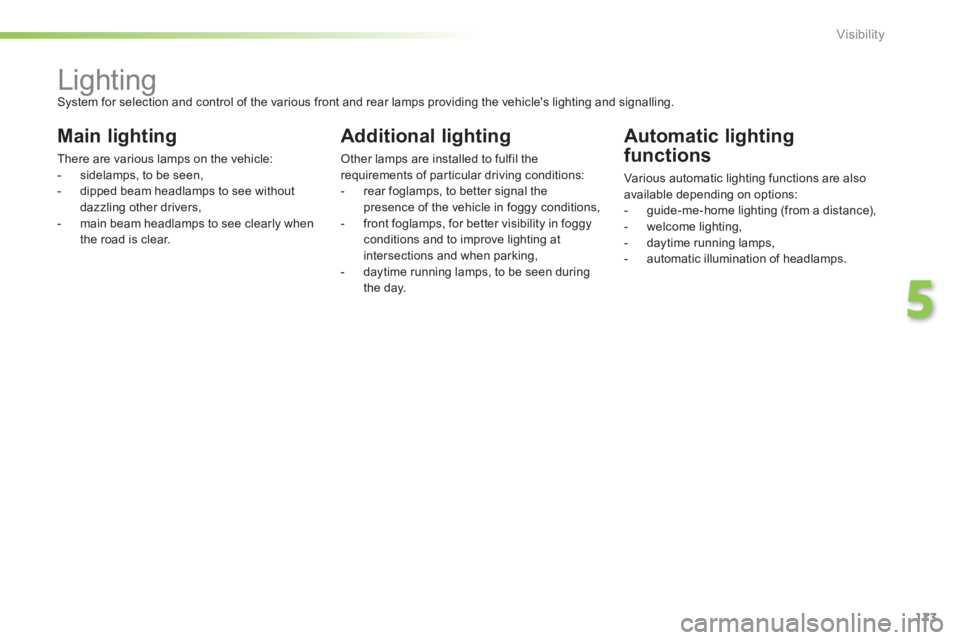
173
5
Visibility
308_EN_CHAP05_VISIBILITE_ED02-2013
Lighting System for selection and control of the various front and rear lamps providing the vehicle's lighting and signalling.
Main lighting
There are various lamps on the vehicle: - sidelamps, to be seen, - dipped beam headlamps to see without dazzling other drivers, - main beam headlamps to see clearly when the road is clear.
Additional lighting
Other lamps are installed to fulfil the requirements of particular driving conditions: - rear foglamps, to better signal the presence of the vehicle in foggy conditions,
- front foglamps, for better visibility in foggy conditions and to improve lighting at intersections and when parking, - daytime running lamps, to be seen during the day.
Automatic lighting
functions
Various automatic lighting functions are also available depending on options: - guide-me-home lighting (from a distance), - welcome lighting, - daytime running lamps, - automatic illumination of headlamps.
Page 177 of 400
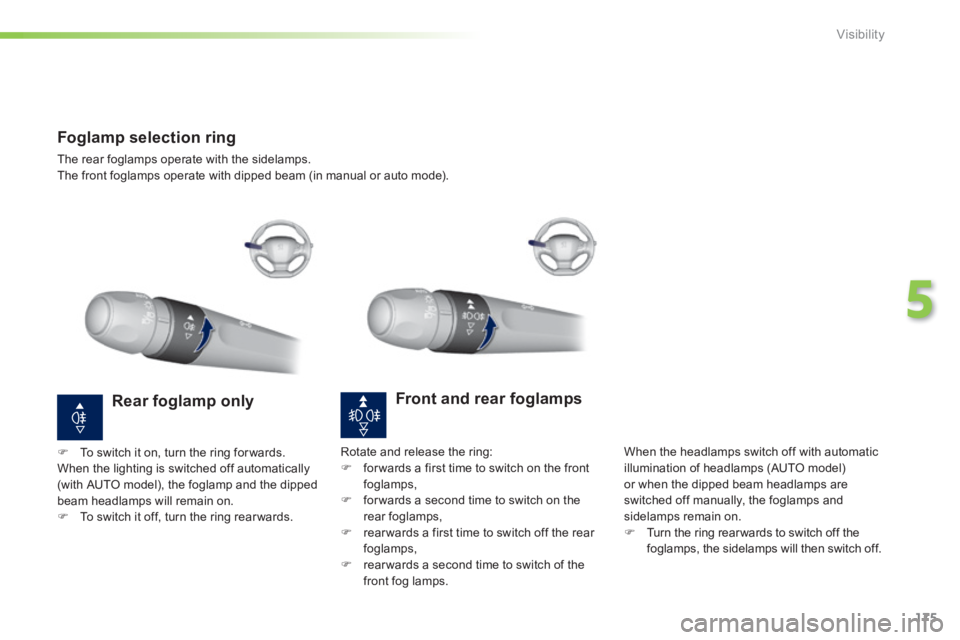
175
5
Visibility
308_EN_CHAP05_VISIBILITE_ED02-2013
Foglamp selection ring
The rear foglamps operate with the sidelamps. The front foglamps operate with dipped beam (in manual or auto mode).
Front and rear foglamps
When the headlamps switch off with automatic illumination of headlamps (AUTO model) or when the dipped beam headlamps are switched off manually, the foglamps and sidelamps remain on. Turn the ring rear wards to switch off the foglamps, the sidelamps will then switch off.
Rear foglamp only
To switch it on, turn the ring for wards. When the lighting is switched off automatically (with AUTO model), the foglamp and the dipped beam headlamps will remain on. To switch it off, turn the ring rear wards.
Rotate and release the ring: for wards a first time to switch on the front foglamps, for wards a second time to switch on the rear foglamps, rear wards a first time to switch off the rear foglamps, rear wards a second time to switch of the front fog lamps.
Page 178 of 400
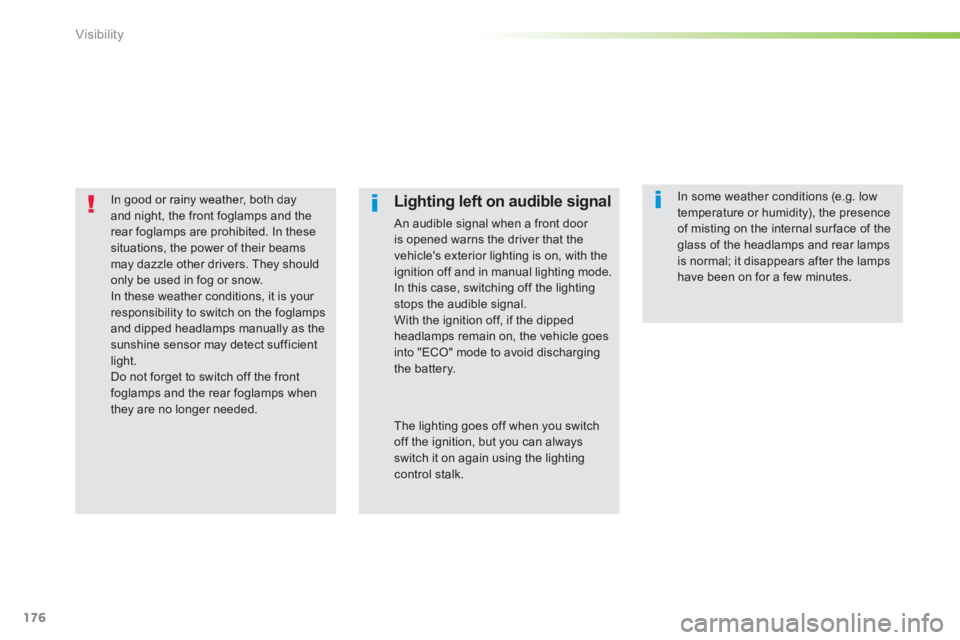
176
Visibility
308_EN_CHAP05_VISIBILITE_ED02-2013
In good or rainy weather, both day and night, the front foglamps and the
rear foglamps are prohibited. In these situations, the power of their beams may dazzle other drivers. They should only be used in fog or snow. In these weather conditions, it is your responsibility to switch on the foglamps and dipped headlamps manually as the sunshine sensor may detect sufficient light. Do not forget to switch off the front foglamps and the rear foglamps when they are no longer needed.
Lighting left on audible signal
An audible signal when a front door is opened warns the driver that the vehicle's exterior lighting is on, with the ignition off and in manual lighting mode. In this case, switching off the lighting stops the audible signal. With the ignition off, if the dipped headlamps remain on, the vehicle goes into "ECO" mode to avoid discharging the battery.
In some weather conditions (e.g. low temperature or humidity), the presence of misting on the internal sur face of the glass of the headlamps and rear lamps is normal; it disappears after the lamps have been on for a few minutes.
The lighting goes off when you switch off the ignition, but you can always switch it on again using the lighting control stalk.
Page 180 of 400
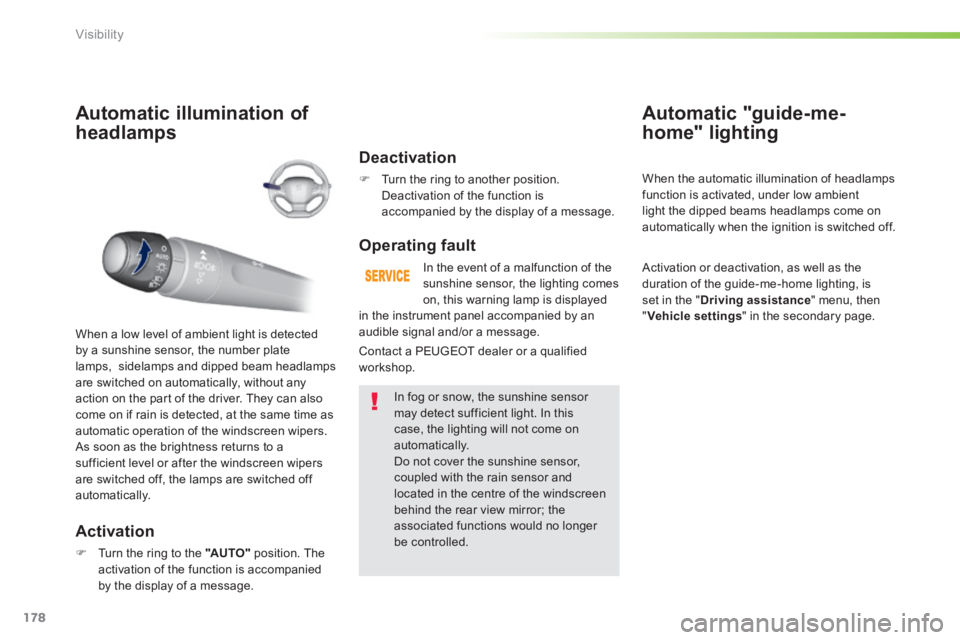
178
Visibility
308_EN_CHAP05_VISIBILITE_ED02-2013
Automatic illumination of
headlamps
Activation
Turn the ring to the "AUTO" position. The activation of the function is accompanied by the display of a message.
When a low level of ambient light is detected by a sunshine sensor, the number plate lamps, sidelamps and dipped beam headlamps are switched on automatically, without any action on the part of the driver. They can also come on if rain is detected, at the same time as
automatic operation of the windscreen wipers. As soon as the brightness returns to a sufficient level or after the windscreen wipers are switched off, the lamps are switched off automatically.
Deactivation
Turn the ring to another position. Deactivation of the function is accompanied by the display of a message.
Operating fault
In the event of a malfunction of the sunshine sensor, the lighting comes on, this warning lamp is displayed
In fog or snow, the sunshine sensor may detect sufficient light. In this case, the lighting will not come on automatically. Do not cover the sunshine sensor, coupled with the rain sensor and located in the centre of the windscreen behind the rear view mirror; the associated functions would no longer be controlled.
Automatic "guide-me-
home" lighting
When the automatic illumination of headlamps function is activated, under low ambient light the dipped beams headlamps come on
automatically when the ignition is switched off.
Activation or deactivation, as well as the duration of the guide-me-home lighting, is set in the " Driving assistance " menu, then " Vehicle settings " in the secondary page.
Contact a PEUGEOT dealer or a qualified workshop.
in the instrument panel accompanied by an audible signal and/or a message.
Page 237 of 400
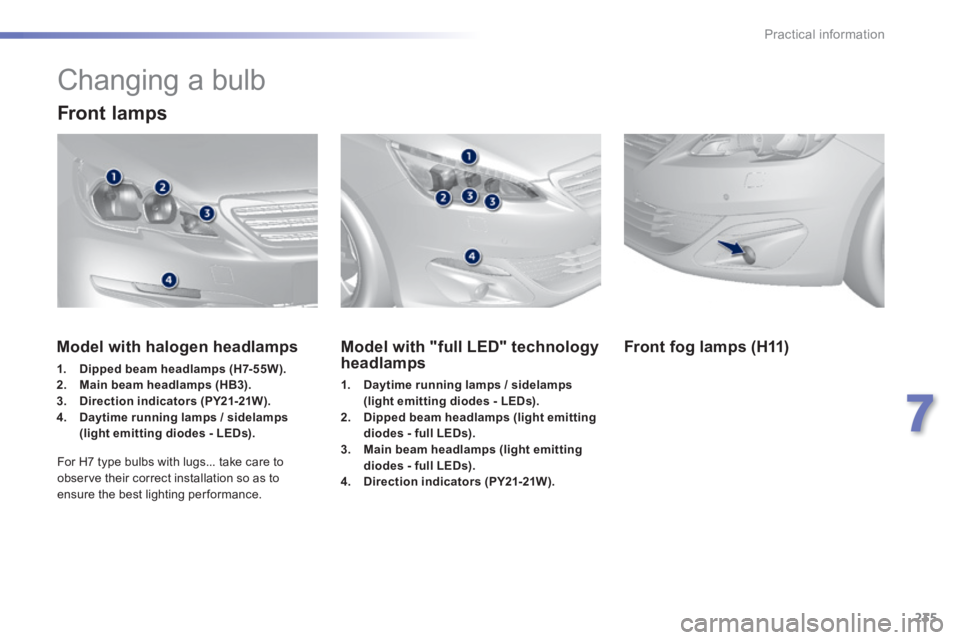
235
7
Practical information
308_EN_CHAP07_INFO PR ATIQUES_ED02-2013
Changing a bulb
Front lamps
Model with "full LED" technology headlamps
1. Daytime running lamps / sidelamps (light emitting diodes - LEDs).2. Dipped beam headlamps (light emitting diodes - full LEDs).3. Main beam headlamps (light emitting diodes - full LEDs).4. Direction indicators (PY21-21W).
Model with halogen headlamps
1. Dipped beam headlamps (H7-55W).2. Main beam headlamps (HB3).3. Direction indicators (PY21-21W).4. Daytime running lamps / sidelamps (light emitting diodes - LEDs).
For H7 type bulbs with lugs... take care to observe their correct installation so as to ensure the best lighting per formance.
Front fog lamps (H11)
Page 241 of 400
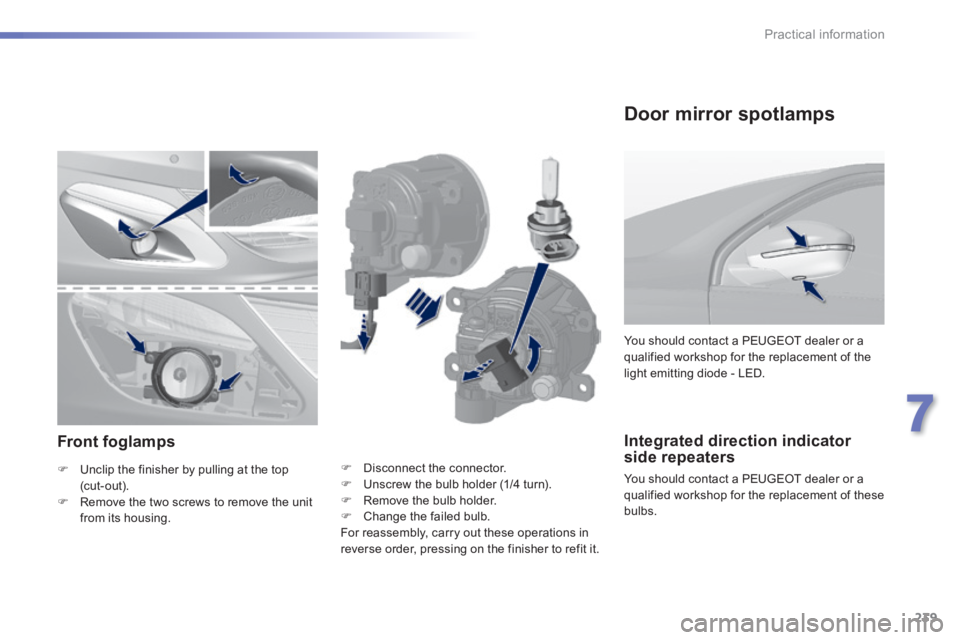
239
7
Practical information
308_EN_CHAP07_INFO PR ATIQUES_ED02-2013
Integrated direction indicator side repeaters
You should contact a PEUGEOT dealer or a qualified workshop for the replacement of these bulbs.
You should contact a PEUGEOT dealer or a qualified workshop for the replacement of the light emitting diode - LED.
Front foglamps
Unclip the finisher by pulling at the top (cut-out). Remove the two screws to remove the unit from its housing.
Disconnect the connector. Unscrew the bulb holder (1/4 turn). Remove the bulb holder. Change the failed bulb. For reassembly, carry out these operations in
reverse order, pressing on the finisher to refit it.
Door mirror spotlamps